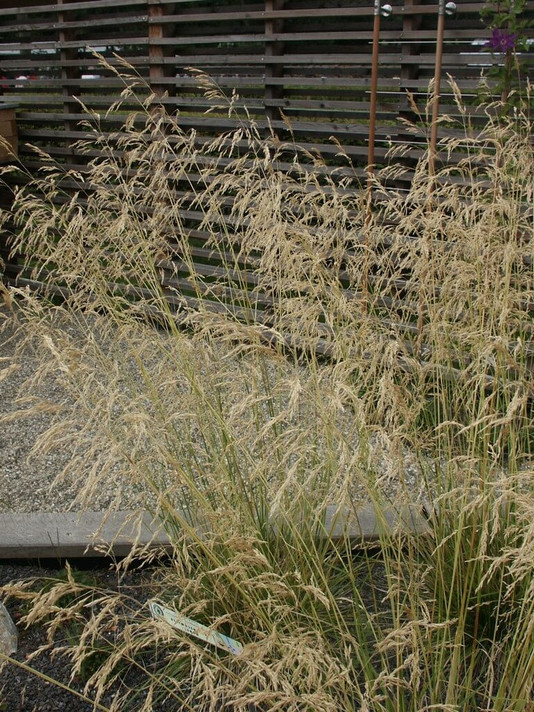Deschampsia caespitosa 'Tardiflora'- TUFTED HAIRGRASS 'TARDIFLORA'
'Tardiflora' is similar to the species, the difference is that it blooms 2-3 week later.
Best in half shade areas with not too-dry soil (likes a bit wet feet). Performs and blooms better in somewhat cooler ares (not suitable for south).
Airy silver-green panicles shortly turn golden-yellow and fade with the season, but persist till winter.
Narrow dark green leaves in regular clumps.
Blooming Time: June/July to September
Size: 2-3’ tall x 2’-3' wide
USDA Zones: 4 to 9
Culture: part shade, dappled shade, grows well in average garden soil that's not too dry, humus-rich moist soil, loam
Moisture Needs: medium, medium-moist
Origin: native to many states in the East and West USA (not found in the hot south): see the USDA distribution map. Naturally grows in cool damp habitats including estuaries, moist mountain meadows, calcareous wetlands, floodplain forests, water margins and marshy grasslands. In the eastern USA it grows in disturbed soggy fields or roadsides. In the western states it can be found in a wide range of montane habitats and alpine meadows.
Deer/Rabbit Resistant: yes / yes
Attracts Butterflies or Pollinators: no
Attracts Hummingbirds: no, but it attracts little birds, providing nesting material for birds and small mammals.
Pot Size: 3.5" x 4" perennial pot (1.22 pt/580 ml)
Plant combinations: This grass is a perfect addition to any woodland garden, woodland edges, large rock gardens or moist areas along ponds or streams. Mixes well with shade-loving perennials such as ferns, Bergenia, Brunnera, Epimedium, Geranium, Helleborus, Omphalodes, Hakonechloa, Hosta. Great combinations can also be made with shorter native perennials like Aquilegia canadensis, A. chrysantha, Asarum, Eupatorium coelestinum, Polemonium repens, Polygonatum diphyllum, Stylophorum diphyllum, woodland Asters or grasses like Carex digitata or Chasmantium latifolium.

Deschampsia caespitosa 'Tardiflora'- TUFTED HAIRGRASS 'TARDIFLORA'
'Tardiflora' is similar to the species, the difference is that it blooms 2-3 week later.
Best in half shade areas with not too-dry soil (likes a bit wet feet). Performs and blooms better in somewhat cooler ares (not suitable for south).
Airy silver-green panicles shortly turn golden-yellow and fade with the season, but persist till winter.
Narrow dark green leaves in regular clumps.
Blooming Time: June/July to September
Size: 2-3’ tall x 2’-3' wide
USDA Zones: 4 to 9
Culture: part shade, dappled shade, grows well in average garden soil that's not too dry, humus-rich moist soil, loam
Moisture Needs: medium, medium-moist
Origin: native to many states in the East and West USA (not found in the hot south): see the USDA distribution map. Naturally grows in cool damp habitats including estuaries, moist mountain meadows, calcareous wetlands, floodplain forests, water margins and marshy grasslands. In the eastern USA it grows in disturbed soggy fields or roadsides. In the western states it can be found in a wide range of montane habitats and alpine meadows.
Deer/Rabbit Resistant: yes / yes
Attracts Butterflies or Pollinators: no
Attracts Hummingbirds: no, but it attracts little birds, providing nesting material for birds and small mammals.
Pot Size: 3.5" x 4" perennial pot (1.22 pt/580 ml)
Plant combinations: This grass is a perfect addition to any woodland garden, woodland edges, large rock gardens or moist areas along ponds or streams. Mixes well with shade-loving perennials such as ferns, Bergenia, Brunnera, Epimedium, Geranium, Helleborus, Omphalodes, Hakonechloa, Hosta. Great combinations can also be made with shorter native perennials like Aquilegia canadensis, A. chrysantha, Asarum, Eupatorium coelestinum, Polemonium repens, Polygonatum diphyllum, Stylophorum diphyllum, woodland Asters or grasses like Carex digitata or Chasmantium latifolium.


